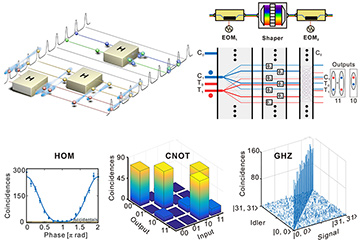 Top row, left: Parallel quantum gates implemented in a single quantum frequency processor. Top row, right: Illustration of frequency-domain quantum interference in a controlled-NOT operation. Bottom row: Hong-Ou-Mandel interference using a tunable frequency beamsplitter, coincidence-basis CNOT gate, and a four-party 32-dimensional GHZ state encoded in time and frequency bins. [Enlarge figure]
Top row, left: Parallel quantum gates implemented in a single quantum frequency processor. Top row, right: Illustration of frequency-domain quantum interference in a controlled-NOT operation. Bottom row: Hong-Ou-Mandel interference using a tunable frequency beamsplitter, coincidence-basis CNOT gate, and a four-party 32-dimensional GHZ state encoded in time and frequency bins. [Enlarge figure]
Quantum technologies promise to revolutionize information processing through dramatic computational speed-ups and ultimate security compared with classical counterparts. As matter-based qubit systems increase in size, however, counteracting decoherence becomes challenging and places limits on how large a stand-alone system can be.
These limitations, coupled with the many quantum computing platforms under development, have led researchers to view modular architectures, connected by a quantum network, as a promising path to large-scale quantum computing. In several studies this year, our group reported progress on multiple fronts in such systems, using photons as quantum information carriers in the frequency domain.
While quantum states are extremely fragile, photons experience virtually no decoherence and are the only realistic choice to carry quantum information over long distances. The same advantages of low loss and massive parallelization in the spectral domain seen in fiber optic networks will be crucial for scaling up quantum networks. But encoding and manipulating photonic quantum information in the frequency degree of freedom (DoF) has received comparatively little attention, despite being more robust against certain fiber transmission impairments than entanglement in other DoFs.
Our work, which builds on recent advances in generating quantum frequency combs,1 offers compelling reasons to challenge the status quo. Using standard telecommunications equipment, we recently demonstrated parallel, independent qubit rotations based on a paradigm that naturally admits massive parallelization of quantum operations in a single spatial mode.2 We also completed the universal quantum gate set by demonstrating a coincidence-basis controlled-NOT gate.3
Another remarkable advantage of frequency is its ability to carry multilevel quantum information (qudits). We leveraged this to encode two qudits in the time and frequency DoFs of a single photon, and implemented the universal gate set across the collective Hilbert space.4,5 Our two-qudit SUM gate generalizes a controlled-NOT gate to higher dimensions and allowed us to generate a four-party 32-dimensional Greenberger-Horne-Zeilinger (GHZ) entangled state—a Hilbert space equivalent to that of 20 qubits, encoded in only two photons.5
These demonstrations should benefit from current efforts to lower power consumption in data communication and high-performance computing. In particular, the migration of photonic systems to integrated platforms could dramatically lower system losses, while simultaneously expanding the dimensionality of quantum operations that can be realized—developments crucial to realizing scalable quantum nodes over fiber optic networks.
Researchers
H.-H. Lu, P. Imany, N.B. Lingaraju, M.S. Alshaykh, O.D. Odele, A.J. Moore, D.E. Leaird, M. Qi and A.M. Weiner, Purdue University, West Lafayette, Ind., USA
J.M. Lukens, B.P. Williams, N.A. Peters and P. Lougovski, Oak Ridge National Laboratory, Oak Ridge, Tenn., USA
J.A. Jaramillo-Villegas, Purdue University, USA, and Universidad Tecnológica de Pereira, Pereira, Risaralda, Colombia
References
1. M. Kues et al. Nat. Photon. 13, 170 (2019).
2. H.-H. Lu et al. Optica 5, 1455 (2018).
3. H.-H. Lu et al. npj Quantum Inf. 5, 24 (2019).
4. H.-H. Lu et al. Phys. Rev. Lett. 120, 030502 (2018).
5. P. Imany et al. npj Quantum Inf. 5, 1 (2019).

